Electrocution Victim: Rottweiler Puppy Case Study
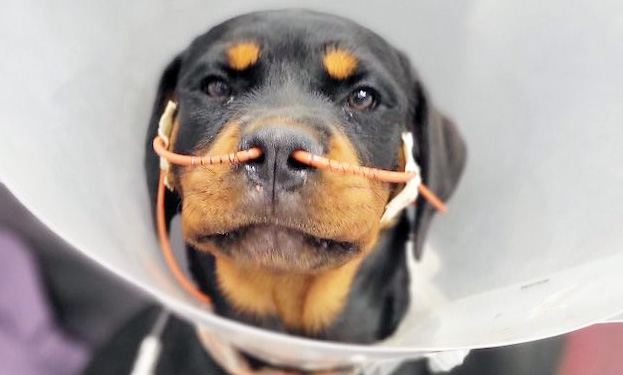
Presentation
Meli, a 4-month-old female Rottweiler puppy, was seen at VERC for increased respiratory effort and eye squinting after the owner woke up to a loud yelp and what sounded like a scuffle. They immediately jumped into action and brought her to VERC.
Clinical Signs & Diagnosis
When Meli arrived, she could lift her head, however, she was squinting and intermittently experiencing episodes of heavy breathing, followed by a non-productive gag and cough. She was immediately provided oxygen supplementation while the doctor examined her. A full-thickness laceration through the gingiva/buccal surface was seen on oral examination, and Meli was drooling excessively. There were no oral burns noted during the examination.
Chest radiographs were performed and revealed a severe caudodorsal alveolar lung pattern known as noncardiogenic pulmonary edema (NPCE). The radio-opaque material seen in the stomach and intestines was suggestive of recent dietary indiscretion and, luckily, not a concern for obstruction. Meli was admitted for oxygen support and observation of any worsened clinical signs. Her owner later called and revealed that they found the cord of the refrigerator had been chewed, confirming that Meli was the victim of self-inflicted household electrocution.
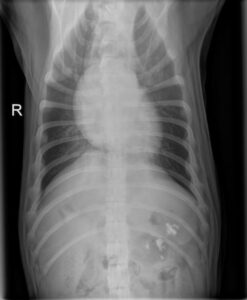
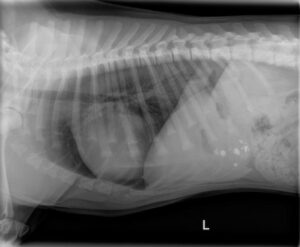
Brief pathophysiology
Pulmonary edema is the abnormal accumulation of fluid inside pulmonary airways and tissues, specifically the pulmonary interstitial tissue, and alveoli. This occurs for several reasons. For focus of this case, pulmonary edema, more specifically noncardiogenic pulmonary edema related to electrocution, is considered a form of neurogenic pulmonary edema (NPE).
NPE is often seen in patients that have experienced severe seizures, intracranial masses, traumatic brain injury, and other neurologic traumas. While the full mechanism of NPE isn’t completely understood, several working theories revolve around an increase in systemic and arterial pressures. In short, this leads to overwhelming left ventricular function, significant catecholamine release, and causes congestion of fluid into the lungs. It occurs due to nervous tissue having a higher ability to conduct electricity which leads to an increase in the predisposition of CNS damage resulting in sympathetic discharge like other types of NPE.
Treatment
Treatment for NCPE revolves mainly around supportive care, oxygen supplementation, pain management, and, debatably, the use of loop diuretics. If the patient arrives in shock, this should be addressed as the first priority. Sometimes, a veterinarian will add terbutaline, a bronchodilator, to the treatment regimen. Wounds are gently cleaned with a diluted oral cleansing solution if oral burns occur. Oxygen saturation levels are monitored non-invasively using a pulse oximeter, and if needed, arterial blood gasses are taken to monitor global oxygenation parameters. Judicious use of IV fluid therapy is commonly needed to maintain hydration and maintain electrolyte balance. Because electrical current can cause a disruption in electrophysiologic impulses, the patient should be monitored for any dysrhythmias on EKG and be treated accordingly based on the chamber of origin (ventricular vs. atrial).
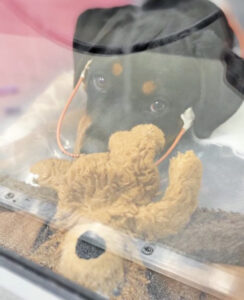
Outcome
Meli was provided oxygen support via nasal cannulation, a common oxygen delivery method used in large-breed canines that need oxygen support when they are too large for oxygen chambers. Nasal cannulation can provide a 30-70% increase in inspired oxygen concentration (FiO2). Furosemide was administered IV, and she was monitored closely throughout the night. Over the first 24 hours of hospitalization, Meli continued to improve. She was weaned off of oxygen supplementation after 16 hours of therapy. She continued to improve hourly and is expected to make a full recovery. She has also stolen the hearts of everyone she has met, and we couldn’t stop taking photos of her cuteness!
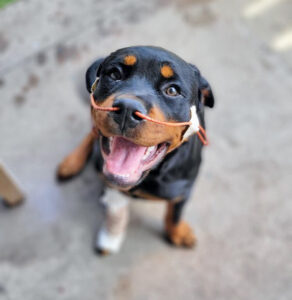
Electrical cord hazard!
Electrical cords are a common hazardous temptation for many pets, especially curious puppies and kittens. In fact, a recent study revealed that 85 % of patients were under five months of age. Another study showed that 70 % of canine patients and 46 % of feline patients that experienced electric cord electrocution were puppies and kittens less than one-year-old. Puppies and kittens often need continuous stimulation when they are not sleeping. Due to curiosity and boredom, if they are not redirected or kept busy, they can often find themselves in dangerous situations simply because they wanted to play and chew on something. Electric shocks that penetrate tissue with low resistance (i.e., wet skin or mucous membranes) often result in more significant injury to the tissue than those that happen on dry tissue, e.g., dry skin, paws, etc.